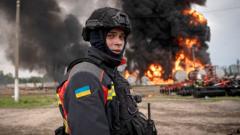In the three years since Russia began its all-out invasion of Ukraine, countless photographers have crafted a visual narrative of both human suffering and resilience on the front lines and within civilian areas. A few have opened up about their experiences and the deep emotional weight carried by their images.
Husband-and-wife duo Vlada and Kostiantyn Liberov, once wedding photographers in Odesa, have pivoted to document the harrowing realities of war. "We moved from capturing love stories to documenting Russian war crimes," Vlada recalls. She herself suffered injuries during her work, leaving shrapnel embedded in her side.
A heartbreaking photograph taken by Kostiantyn during a Ukrainian offensive in Russia's Kursk region captures a soldier comforting a comrade mourning a fallen friend. This poignant moment reflects the moral complexity and heartache the military faces, as soldiers grapple with loss not just in defense of their homeland, but on foreign soil.
Vlada's work also sheds light on those left behind in conflict zones. One notable image depicts a police officer from Ukraine’s White Angels unit, tasked with helping civilians evacuate before intense bombardment. "The next day we could not return because of the heavy shelling," she said, highlighting her struggle with the memories of those who could not escape.
Photojournalists, like Valeria Demenko, who shadows emergency services in the Sumy region, bear witness to the aftermath of destruction. Demenko vividly describes how her team had to recover bodies from a collapsed building, an experience that haunts her due to the lost lives represented in the rubble.
Alexander Ermochenko, with over a decade of documenting the conflicts in the Donetsk region, echoes the sentiment of shared suffering, stating, “The fear on the face of the owner of a destroyed house is the same on both sides of the front.” He reminds us that the brutal reality of war transcends borders—every person suffers in some form.
In Kyiv, Alina Smutko depicts life amid the chaos, sharing how regular life has been punctuated by air raid alerts, leading to a community forged in resilience. She believes that while images cannot stop war, documenting these experiences is imperative: “If something hasn't been photographed, it hasn't happened.”
Through their lenses, these photographers invite the world to see the human side of conflict—both the despair and fleeting moments of humanity that remind us why they continue to work tirelessly, sometimes at great personal risk. Their collective aim is to preserve the memory of those affected and ensure that the voices of the voiceless are heard.






















